During Marvel Comics' Silver Age heyday, in the 1960's, the three comic features that best showed off the synergy of the Stan Lee/Jack Kirby team were THE FANTASTIC FOUR, CAPTAIN AMERICA, and THOR. Each title showed a different aspect of Kirby mastery of comics art. The FF showcased Kirby's talent for science fiction, fostered by his lifelong love for SF literature and his fascination with new technologies. CAPTAIN AMERICA, which Kirby co-created with Joe Simon in the 1940's, reflected his love of action and his depiction of street-level brawling raised to a high art. And THOR was his fantasy title, in which he took his interest in mythology and mixed it with his science-fiction sensability to create his take on the Norse myths -- one in which Asgard is a gleaming metropolis of impossible architecture, with gleaming-plated warriors galloping horses across the Rainbow Bridge with nebulae and exploding stars hanging in the sky above.
Of the many accomplishments of Marvel Studios' and director Kenneth Branagh's movie adaption of THOR, the greatest is that it has brought Kirby's fantastic vision to life. Early in the movie, we see Thor, Loki, Sif, and the Warriors Three galloping their horses across Bifrost, the skies crowded with astronomical phenomena, and the scene looks like a Kirby panel brought to life.
This is an aspect that has been missing from the previous Marvel movies. In part, this is because the previous movies involved characters with which Kirby was less involved. SPIDER-MAN was primarily the visual creation of Steve Ditko and his artistic successor on the strip, John Romita. X-MEN was created by Lee and Kirby, but the movies focused less on Kirby's era and more on the modern incarnation of the mutants, capturing the look of artists such as Neal Adams, Dave Cockrum and John Byrne. Similarly, the Hulk was co-created by Kirby, but most of his adventures were drawn by other artists. Same for IRON MAN. As for the FANTASTIC FOUR movies, they did capture Kirby's versions of The Thing and the Silver Surfer, but squandered the chance to adapt Kirby's talents for set and technology design.
But THOR brings the Kirby. Not only in depicting Asgard, but also in the costume and armor design, the depiction of Thor in action (Thor's spinning hammer was thrilling to watch), and Kirby's giant-robot creation The Destroyer (which some critics derided as generic, probably because others have ripped off the design).
All that eye candy would be wasted, of course, if the movie weren't entertaining otherwise. Chris Hemsworth radiates tremendous charisma and likeability as Thor, which is essential since the character starts off the movie as an arrogant bully. Anthony Hopkins does such a good job as Odin (a kinder and gentler Odin than the tyrannical papa in the comics) that it's hard to imagine who else could play the part. And Tom Hiddleston as Loki manages to play his villainy so subtly that you can imagine why people continue to trust a guy who's, y'know, a trickster god. Further, although they play only supporting roles, the actors who play The Warriors Three (essentially taken whole from the comics, except Volstagg, who was apparently redesigned to resemble Gimli from the Lord of the Rings trilogy) and Sif are terrific.
The story (the product of a committee, most notably including comics and SF writer J. Michael Strazcynski) isn't brilliant, but it serves the movie. Notably, Thor's character arc of developing humility isn't accomplished through spending years as a lame doctor on earth (as in the comics) but through a couple of days of being mortal and powerless. After all, everything's speeded up in Hollywood. But it works.
THOR leaves me with high hopes for the next Kirby creation to appear on the big screen, in a couple of months, from the same studio: CAPTAIN AMERICA.
The scattershot musings of a Los Angeles appellate attorney and devotee of popular culture
Showing posts with label Comic movies. Show all posts
Showing posts with label Comic movies. Show all posts
Sunday, May 15, 2011
Sunday, August 29, 2010
Scott Pilgrim vs. Movie Audiences
We saw SCOTT PILGRIM VS. THE WORLD last night, and had a great time. I wouldn't want every movie, or even every comic-book adaptation, to be like this; but as a stand-alone cinema experiment, it worked nicely.
The movie essentially handles the ups and downs of a relationship between two young people (and the others in their lives) as an exercise in video game reality. Thus Scott must do more than compete with his new girlfriend's memories of her various exes; he must actually battle and vanquish them. And, without explanation, they and he have the sort of superpowers, battle abilities, and resilience seen only in video games and superhero comics. That results in a quirky mixture of honest human interaction and over-the-top stylized violence, complete with jump-cut editing, written-out sound effects, and real-life manifestations of cartoon symbols for emotion (a girl literally has stars in her eyes; a face turns into an emoticon).
It's well-done and well-acted enough that it veers more toward entertainment than annoyance. I hope this film has a second life on video.
The movie essentially handles the ups and downs of a relationship between two young people (and the others in their lives) as an exercise in video game reality. Thus Scott must do more than compete with his new girlfriend's memories of her various exes; he must actually battle and vanquish them. And, without explanation, they and he have the sort of superpowers, battle abilities, and resilience seen only in video games and superhero comics. That results in a quirky mixture of honest human interaction and over-the-top stylized violence, complete with jump-cut editing, written-out sound effects, and real-life manifestations of cartoon symbols for emotion (a girl literally has stars in her eyes; a face turns into an emoticon).
It's well-done and well-acted enough that it veers more toward entertainment than annoyance. I hope this film has a second life on video.
Sunday, August 17, 2008
The Dark Knight Falls . . . to Number 2
I have not seen "Tropic Thunder," but I understand that people are picketing it because some characters in it who are stupid say some stupid things, and the picketing folks believe that even stupid characters should not say stupid things in movies. (Me, I get offended when smart, sympathetic, nominal heroes in movies say offensive things. Sometimes.)
Anyway, the picketing folks may not realize that there is no such thing as bad publicity in Hollywood; or that the best thing for box office is being picketed. "Tropic Thunder" rules the box office this weekend, actually upsetting "The Dark Knight" from the # 1 perch it has occupied and defended for a month.
"The Clone Wars," meanwhile, is #3 -- a far cry from the live-action STAR WARS movies (even the really badly-scripted and directed ones) that ruled the box office. Maybe if they had put Shreck it it, it would have done better.
Anyway, the picketing folks may not realize that there is no such thing as bad publicity in Hollywood; or that the best thing for box office is being picketed. "Tropic Thunder" rules the box office this weekend, actually upsetting "The Dark Knight" from the # 1 perch it has occupied and defended for a month.
"The Clone Wars," meanwhile, is #3 -- a far cry from the live-action STAR WARS movies (even the really badly-scripted and directed ones) that ruled the box office. Maybe if they had put Shreck it it, it would have done better.
Saturday, July 19, 2008
Joker's Wild
Yesterday we saw THE DARK KNIGHT; and apparently we weren't alone. Estimates peg the latest Bat-movie at pulling in around $155 million this weekend, making for the best opening weekend ever for a film, and posturing DARK KNIGHT to go head-to-head with IRON MAN for top movie of the summer. (I find appropriate that these two armored billionaires should grapple mano-a-mano for supremecy. It's the old Marvel vs. DC battles all over again.)
[some mild SPOILERS coming up . . . ]
The one aspect of the DARK KNIGHT I found weak was the bat-suit. In several sequences, especially near the beginning of the film, when it is shown in the light it merely looks silly. I do appreciate the redesign of the bat-armor worked into the movie -- "You'd like to be able to turn your head?" quips armourer Lucius Fox -- but at this point the best design might be the simple look of the comics suit. If Batman is looking for flexible, why not a light mesh armor suit, perhaps of grey or black?
On the other hand, I liked the scenes near the end of the film where the filmakers finally gave Batman an excuse to sport the "blunked-out eyes" that have been his trademark in the comics for decades.
Those notes out of the way, I can see why the DARK KNIGHT is garnering the raves that it is. It shows that a filmmaker can bring to an urban superhero project the sort of bravura filmmaking usually reserved for films like THE FRENCH CONNECTION. Despite being confined to Gotham City, it is expansive, giving the impression that every decision and action the characters make affects millions. (Remember how, in Tim Burton's first Batman movie, Gotham City seemed to consist of about two blocks?) It echoes several moments in the comics, without actually directly copying any scenes from them -- although a scene near the end is very close to one in BATMAN: YEAR ONE. It shows that the third act of a superhero film can consist of more than the hero and villain tearing up the scenery as they pummel each other. (A common feature of IRON MAN and THE INCREDIBLE HULK.)
But the biggest takeaway from the film is Heath Ledger's bravura performance as The Joker -- a performance that would stand out even if it was not his last completed role before his untimely death.

I find fascinating that each of the three most memorable portrayals of the Joker -- Jack Nicholson's in 1989's BATMAN, Mark Hamill as the voice of the knave in BATMAN: THE ANIMATED SERIES in the '90's, and Ledger in this film -- plays the character completely differently; and none quite duplicates the skeletal, grinning killer that either Bob Kane or Jerry Robinson (conflicting accounts) created in 1940, and which Denny O'Neil and Neal Adams redesigned in the seventies.
 Ledger's portrayal eschews the dead-white skin, green hair and ruby lips as the character's permanent look; the filmmakers found more in keeping with their "realistic" take on the story that Ledger's character would be nuts enought to wear "war paint" makeup instead. His slow-burn delivery eschews the manic approach that Nicholson and Hamill took. And Ledger really does not smile very much (apart from the false "smile" his scars create), and doesn't give out with one of the Joker's chilling laughs until quite a way into the story.
Ledger's portrayal eschews the dead-white skin, green hair and ruby lips as the character's permanent look; the filmmakers found more in keeping with their "realistic" take on the story that Ledger's character would be nuts enought to wear "war paint" makeup instead. His slow-burn delivery eschews the manic approach that Nicholson and Hamill took. And Ledger really does not smile very much (apart from the false "smile" his scars create), and doesn't give out with one of the Joker's chilling laughs until quite a way into the story.
Yet he hits upon the center of the character, as portrayed initially in the comics and from the '70's on: the Joker's sense of mystery, aided by his unreliable accounts of his origins; his monumental ego, justifying any horrific, large scale act just to satisfy his whims; his psychotic unpredictability; his cunning, here manifested in his mastery of strategy; and his attachment to Batman as his perfect straight man.
There will be other interpretations of the rivalry between Batman and the Joker in the future. They will likely be as different from this movie as the movie is different from what came before. One can only hope they'll be as original and yet as spot-on as this one.
[some mild SPOILERS coming up . . . ]
The one aspect of the DARK KNIGHT I found weak was the bat-suit. In several sequences, especially near the beginning of the film, when it is shown in the light it merely looks silly. I do appreciate the redesign of the bat-armor worked into the movie -- "You'd like to be able to turn your head?" quips armourer Lucius Fox -- but at this point the best design might be the simple look of the comics suit. If Batman is looking for flexible, why not a light mesh armor suit, perhaps of grey or black?
On the other hand, I liked the scenes near the end of the film where the filmakers finally gave Batman an excuse to sport the "blunked-out eyes" that have been his trademark in the comics for decades.
Those notes out of the way, I can see why the DARK KNIGHT is garnering the raves that it is. It shows that a filmmaker can bring to an urban superhero project the sort of bravura filmmaking usually reserved for films like THE FRENCH CONNECTION. Despite being confined to Gotham City, it is expansive, giving the impression that every decision and action the characters make affects millions. (Remember how, in Tim Burton's first Batman movie, Gotham City seemed to consist of about two blocks?) It echoes several moments in the comics, without actually directly copying any scenes from them -- although a scene near the end is very close to one in BATMAN: YEAR ONE. It shows that the third act of a superhero film can consist of more than the hero and villain tearing up the scenery as they pummel each other. (A common feature of IRON MAN and THE INCREDIBLE HULK.)
But the biggest takeaway from the film is Heath Ledger's bravura performance as The Joker -- a performance that would stand out even if it was not his last completed role before his untimely death.

I find fascinating that each of the three most memorable portrayals of the Joker -- Jack Nicholson's in 1989's BATMAN, Mark Hamill as the voice of the knave in BATMAN: THE ANIMATED SERIES in the '90's, and Ledger in this film -- plays the character completely differently; and none quite duplicates the skeletal, grinning killer that either Bob Kane or Jerry Robinson (conflicting accounts) created in 1940, and which Denny O'Neil and Neal Adams redesigned in the seventies.
 Ledger's portrayal eschews the dead-white skin, green hair and ruby lips as the character's permanent look; the filmmakers found more in keeping with their "realistic" take on the story that Ledger's character would be nuts enought to wear "war paint" makeup instead. His slow-burn delivery eschews the manic approach that Nicholson and Hamill took. And Ledger really does not smile very much (apart from the false "smile" his scars create), and doesn't give out with one of the Joker's chilling laughs until quite a way into the story.
Ledger's portrayal eschews the dead-white skin, green hair and ruby lips as the character's permanent look; the filmmakers found more in keeping with their "realistic" take on the story that Ledger's character would be nuts enought to wear "war paint" makeup instead. His slow-burn delivery eschews the manic approach that Nicholson and Hamill took. And Ledger really does not smile very much (apart from the false "smile" his scars create), and doesn't give out with one of the Joker's chilling laughs until quite a way into the story.Yet he hits upon the center of the character, as portrayed initially in the comics and from the '70's on: the Joker's sense of mystery, aided by his unreliable accounts of his origins; his monumental ego, justifying any horrific, large scale act just to satisfy his whims; his psychotic unpredictability; his cunning, here manifested in his mastery of strategy; and his attachment to Batman as his perfect straight man.
There will be other interpretations of the rivalry between Batman and the Joker in the future. They will likely be as different from this movie as the movie is different from what came before. One can only hope they'll be as original and yet as spot-on as this one.
That's Entertainment
This is the delightful image that greeted me when I pulled my subscription copy of ENTERTAINMENT WEEKLY from the mailbox:

Since EW is published by Warner, which also (a) owns DC Comics, which owns the rights to WATCHMEN and (b) is making the WATCHMEN movie, I suppose it's only natural that EW would score an exclusive WATCHMAN cover.
I still maintain a healthy skepticism that director Snyder can take this massive epic of a graphic novel and condense it down to even a 2 1/2-hour movie and still maintain the spirit of the thing. But images like these give me hope.
++++++Edit++++++++++++++++++++++++++++++++++++++++++++++++++++++++++++++++++++++++++
Okay, this trailer gives me even more hope. Rorschach's voice near the end of the trailer is damn near perfect.

Since EW is published by Warner, which also (a) owns DC Comics, which owns the rights to WATCHMEN and (b) is making the WATCHMEN movie, I suppose it's only natural that EW would score an exclusive WATCHMAN cover.
I still maintain a healthy skepticism that director Snyder can take this massive epic of a graphic novel and condense it down to even a 2 1/2-hour movie and still maintain the spirit of the thing. But images like these give me hope.
++++++Edit++++++++++++++++++++++++++++++++++++++++++++++++++++++++++++++++++++++++++
Okay, this trailer gives me even more hope. Rorschach's voice near the end of the trailer is damn near perfect.
Sunday, August 19, 2007
Who's the Creator?
On his blog, comics creator Stephen Bissette writes about his pleasure that the illustrator of Neil Gaiman's novel Stardust, Charles Vess, is given credit as co-creator of the source material in the Paramount movie adaptation of the book. He also writes about how movie adaptations of comic books seldom give credit to illustrators; and that the whole concept of giving creators credit for comics has been dodgy at least since Alan Moore insisted that his name be taken off the credits for V for Vendetta and Constantine (and that he receive no money for them).
That got me thinking about the provenance issues for movie adaptations of comic book characters who have been around for decades, and who are the product of diverse hands over the ages.
That isn't a problem with Stardust, since it was a standalone illustrated novel with one writer and one artist. But consider a character such as Marvel's Wolverine. Wolverine apparently originated as a suggestion by editor Roy Thomas, which writer Len Wein developed. The visual design for Wolverine was devised by John Romita. Wein and artist Herb Trimpe then created the first comic-book adventure for the Canadian mutant. Then Wolverine was picked up for the revived X-Men comic; and the cover artists for the first appearance of the New X-Men, Gil Kane, redesigned Wolverine's costume into the look more familiar today. Dave Cockrum illustrated the X-Men issues with Wolverine. Then after an issue and a half, writer Chris Claremont took over. He, more than any other creator before or since, shaped Wolverine's character into the one eventually depicted in the X-Men movies decades later.
So who created Wolverine? Who would you credit in the upcoming Wolverine movie?
Or take Batman. Bob Kane, who devised the original concept for Batman, had a contract with DC for years requiring that he be credited as the creator of the Dark Knight. But writer Bill Finger reportedly devised Batman's look, as well as much of his background; and is credited by most as at least the co-creator of Batman.
But the story does not end there. The Batman who appeared in the 2005 movie BATMAN BEGINS did not step unalloyed out of the character's first 1939 comic book appearance.
In the federal district court opinion, Netzer v. Continuity Graphic Associates, Inc.,
963 F.Supp. 1308 (S.D.N.Y. 1997), Judge Sweet wrote about Neal Adams, "Adams was and is a comic book and commercial artist well known in his field for, among other things, his creation of Batman." That is quite a trick, considering that Adams was born after the first comic book appearance of Batman. Yet, in a way, it is true. Adams is not the creator of Batman, but he is a creator of Batman. His artwork for Batman stories in the late '60's and early '70's, which visually redefined the character, created (in part) the version of the charactor that exists today -- the one depicted in BATMAN BEGINS. (Indeed, according to Adams's Website, Adams received some money from Warner for the movie -- in part, perhaps, because a character Adams indisputably co-created, Ra's al Ghul, is in the movie.) By the same logic, Frank Miller, David Mazzuchelli, Steve Engelhart, Marshall Rogers, Dick Giordano, Denny O'Neil, and several others might be considered "creators" of Batman. Who do you credit?
The creator-credit issue becomes even more complicated when the issue of creation is in dispute. Comics writer Gary Friedrich is currently suing Marvel over the ownership of the character Ghost Rider. Friedrich, who wrote the intial appearances of the supernatural cyclist, contends he created the character and brought him to Marvel. Roy Thomas has written that he came up with the concept of a skull-headed (or masked) cyclist; and artist Mike Ploog added the flames streaming from the character's head. Ploog has stated he doesn't remember who came up with the character. Small wonder that the recent GHOST RIDER movie didn't credit any writer or artist for creating the character. (Unsurprisingly, when Friedrich, Ploog, and Thomas sat together on a Marvel '60's and '70's panel at the Comic-Con last month, the subject of Ghost Rider didn't come up. Instead, Friedrich and Thomas talked fondly of their pre-comic-book days together as ushers in Missouri.)
The first step in deciding whether or how to credit comic book creators of decades-old characters is to answer the question: who are the creators?
That got me thinking about the provenance issues for movie adaptations of comic book characters who have been around for decades, and who are the product of diverse hands over the ages.
That isn't a problem with Stardust, since it was a standalone illustrated novel with one writer and one artist. But consider a character such as Marvel's Wolverine. Wolverine apparently originated as a suggestion by editor Roy Thomas, which writer Len Wein developed. The visual design for Wolverine was devised by John Romita. Wein and artist Herb Trimpe then created the first comic-book adventure for the Canadian mutant. Then Wolverine was picked up for the revived X-Men comic; and the cover artists for the first appearance of the New X-Men, Gil Kane, redesigned Wolverine's costume into the look more familiar today. Dave Cockrum illustrated the X-Men issues with Wolverine. Then after an issue and a half, writer Chris Claremont took over. He, more than any other creator before or since, shaped Wolverine's character into the one eventually depicted in the X-Men movies decades later.
So who created Wolverine? Who would you credit in the upcoming Wolverine movie?
Or take Batman. Bob Kane, who devised the original concept for Batman, had a contract with DC for years requiring that he be credited as the creator of the Dark Knight. But writer Bill Finger reportedly devised Batman's look, as well as much of his background; and is credited by most as at least the co-creator of Batman.
But the story does not end there. The Batman who appeared in the 2005 movie BATMAN BEGINS did not step unalloyed out of the character's first 1939 comic book appearance.
In the federal district court opinion, Netzer v. Continuity Graphic Associates, Inc.,
963 F.Supp. 1308 (S.D.N.Y. 1997), Judge Sweet wrote about Neal Adams, "Adams was and is a comic book and commercial artist well known in his field for, among other things, his creation of Batman." That is quite a trick, considering that Adams was born after the first comic book appearance of Batman. Yet, in a way, it is true. Adams is not the creator of Batman, but he is a creator of Batman. His artwork for Batman stories in the late '60's and early '70's, which visually redefined the character, created (in part) the version of the charactor that exists today -- the one depicted in BATMAN BEGINS. (Indeed, according to Adams's Website, Adams received some money from Warner for the movie -- in part, perhaps, because a character Adams indisputably co-created, Ra's al Ghul, is in the movie.) By the same logic, Frank Miller, David Mazzuchelli, Steve Engelhart, Marshall Rogers, Dick Giordano, Denny O'Neil, and several others might be considered "creators" of Batman. Who do you credit?
The creator-credit issue becomes even more complicated when the issue of creation is in dispute. Comics writer Gary Friedrich is currently suing Marvel over the ownership of the character Ghost Rider. Friedrich, who wrote the intial appearances of the supernatural cyclist, contends he created the character and brought him to Marvel. Roy Thomas has written that he came up with the concept of a skull-headed (or masked) cyclist; and artist Mike Ploog added the flames streaming from the character's head. Ploog has stated he doesn't remember who came up with the character. Small wonder that the recent GHOST RIDER movie didn't credit any writer or artist for creating the character. (Unsurprisingly, when Friedrich, Ploog, and Thomas sat together on a Marvel '60's and '70's panel at the Comic-Con last month, the subject of Ghost Rider didn't come up. Instead, Friedrich and Thomas talked fondly of their pre-comic-book days together as ushers in Missouri.)
The first step in deciding whether or how to credit comic book creators of decades-old characters is to answer the question: who are the creators?
Monday, July 30, 2007
Comic-Con International: San Diego -- A Retrospective
I am still feeling the lingering exhaustion of our annual trip to what used to be known as the San Diego Comic-Con; but is now Comic-Con: San Diego. But most of my photos are up now on Photobucket.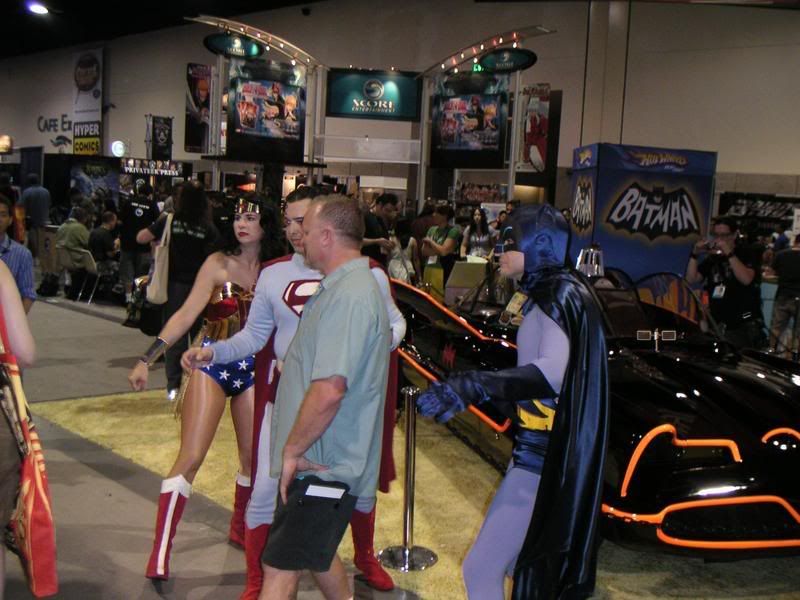
I had ambitions of posting blog entries and photos during the con; but the wrinkle in that plan was the meltdown of the con hotel reservation system, which resulted in every room in the convention block being reported as reserved within minutes of reservations going on-line. As a result, we ended up at the Holiday Inn on Hotel Circle, about eight miles from the convention center. Fortunately, despite the dire warnings on the con Website about nonexistent downtown parking, we got to town early every day and found covered parking at a building a block from Petco Park. It was a fair walk (seven blocks) from the convention center -- a trek complicated by the freight train that passed in front of the center every morning and night -- but it beat relying on public transportation to get to the center.
Here are some highlights -- and low-lights -- from this year's convention:
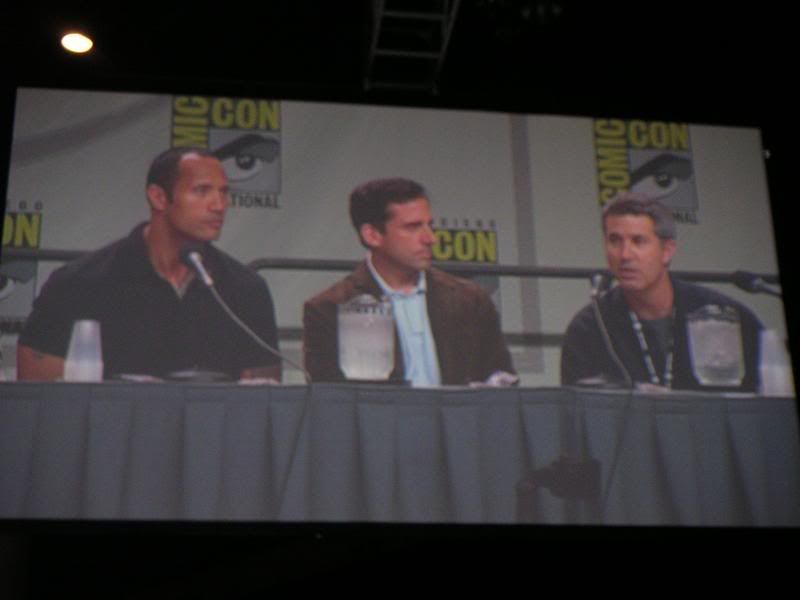
--As the above photo shows, Hollywood's love affair with Comic-Con (which waxed with the evolution of the Web, which allows thousands of attendees to rave or rant online as soon as they've seen the latest film preview) continues unabated. One of the best-looking previews I saw was the one at the Warner Brothers panel for the movie remake of GET SMART. Generally I think little of movie remakes of TV series -- particularly comedies -- but this one, starring Steve Carrell as Maxwell Smart, The Rock as his mentor, Anne Hathaway as 99, Alan Arkin as The Chief, Terence Stamp as Siegfried, and Masi Oka from HEROES as an armorer, looks delightful. Reportedly, Mel Brooks and Buck Henry are giving their blessing to this one (especially since it will likely make them a few more sheckels).
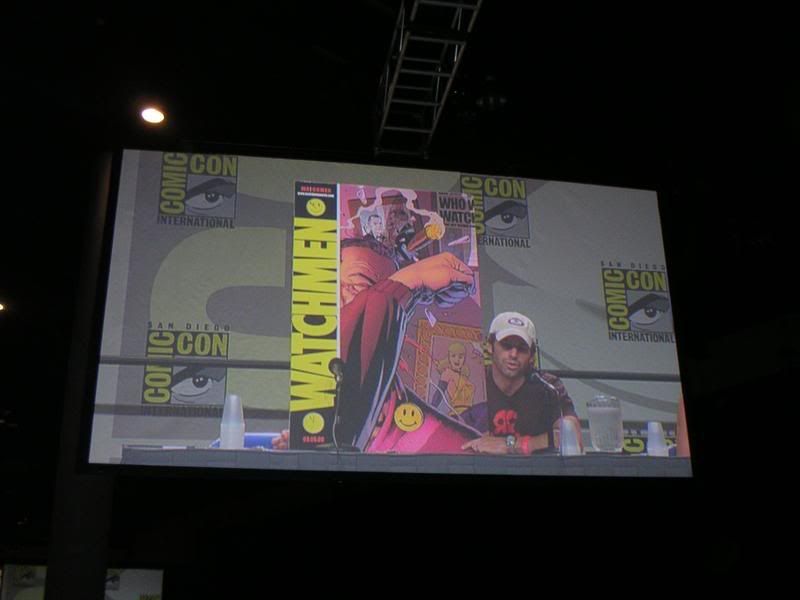
--Another highlight of the Warner Brothers panel was the presentation for the upcoming WATCHMEN movie. This project has been in and out of several film creators' hands for over twenty years; but if anyone can get it made, it's Zack Snyder. Snyder showed his adaptation chops this year by making a version of Frank Miller's 300 that had no stars, and yet grossed huge amounts of dinars. Here he poses with the poster WATCHMEN artist Dave Gibbons drew for the film project.

-- But the most exciting film project for me was the preview at the Marvel Studios panel for Jon Favreau's IRON MAN film.
The flick wrapped principle photography last month; and according to Favreau, because he prefers "practical" special effects (i.e., those done on-camera and in the camera) to CGI, the film will not require huge amounts of post-production. Favreau showed four minutes of footage, selected, he said, not to sell the movie to those unfamiliar with the character, but to convince comics fans that he was doing Shellhead right. And, speaking as someone who's been a Marvel fan for over 30 years, he nailed it.
In the footage, Robert Downey, Jr. portrayed IM's alter ego, Tony Stark, as a character reminiscent of Joe Gideon in ALL THAT JAZZ: an arrogant jerk who is so charismatic that people love him despite themselves. He's the sort who will pose for a photo with a soldier; but when the soldier flashes a peace sign, Stark snaps, "No gang signs." And the scenes with the armor. My goodness, people. The scenes with Stark clunking around in the early "Mark I" armor, battling a squad of soldiers, looked taken straight out of Shellhead's first appearance in TALES OF SUSPENSE. And the closing scenes in the trailer, where IM's red-and-gold armor is rocketing through the air, out-running F-16's . . . well, I was suddenly 12 years old again, buying comics at the 7-11 on a warm summer night.
Above is a photo with Favreau, Downey, and co-stars Terence Howard and Gwyneth Paltrow.
I was not among those who were lucky enough to see the Mark I armor in all its glory at the Marvel booth; but I did get to see the massive crate in which it was housed -- and to snap a picture when the handler cracked open the crate to give us a glimpse of the gleaming cargo inside.
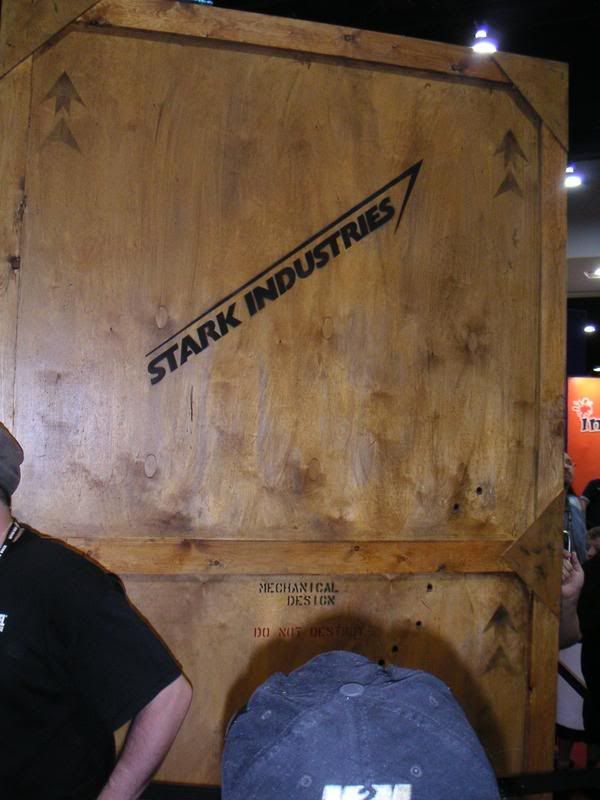
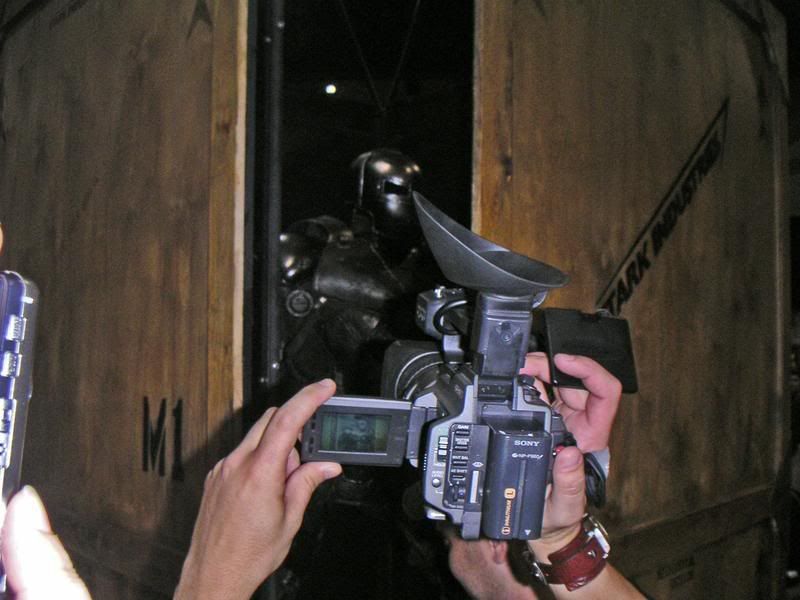
More photos and con reminisces later. For now, I'll leave you with a photo of Willy Wonka, who's beside himself.
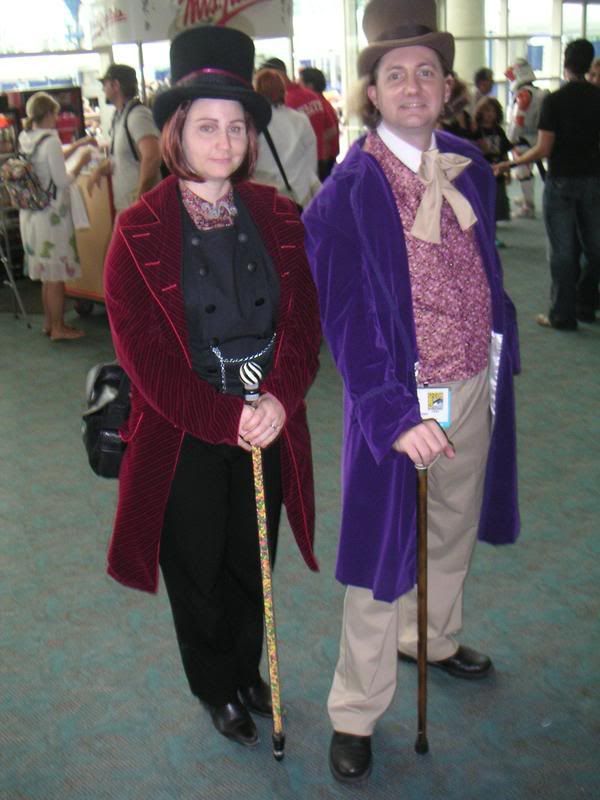

I had ambitions of posting blog entries and photos during the con; but the wrinkle in that plan was the meltdown of the con hotel reservation system, which resulted in every room in the convention block being reported as reserved within minutes of reservations going on-line. As a result, we ended up at the Holiday Inn on Hotel Circle, about eight miles from the convention center. Fortunately, despite the dire warnings on the con Website about nonexistent downtown parking, we got to town early every day and found covered parking at a building a block from Petco Park. It was a fair walk (seven blocks) from the convention center -- a trek complicated by the freight train that passed in front of the center every morning and night -- but it beat relying on public transportation to get to the center.
Here are some highlights -- and low-lights -- from this year's convention:

--As the above photo shows, Hollywood's love affair with Comic-Con (which waxed with the evolution of the Web, which allows thousands of attendees to rave or rant online as soon as they've seen the latest film preview) continues unabated. One of the best-looking previews I saw was the one at the Warner Brothers panel for the movie remake of GET SMART. Generally I think little of movie remakes of TV series -- particularly comedies -- but this one, starring Steve Carrell as Maxwell Smart, The Rock as his mentor, Anne Hathaway as 99, Alan Arkin as The Chief, Terence Stamp as Siegfried, and Masi Oka from HEROES as an armorer, looks delightful. Reportedly, Mel Brooks and Buck Henry are giving their blessing to this one (especially since it will likely make them a few more sheckels).

--Another highlight of the Warner Brothers panel was the presentation for the upcoming WATCHMEN movie. This project has been in and out of several film creators' hands for over twenty years; but if anyone can get it made, it's Zack Snyder. Snyder showed his adaptation chops this year by making a version of Frank Miller's 300 that had no stars, and yet grossed huge amounts of dinars. Here he poses with the poster WATCHMEN artist Dave Gibbons drew for the film project.

-- But the most exciting film project for me was the preview at the Marvel Studios panel for Jon Favreau's IRON MAN film.
The flick wrapped principle photography last month; and according to Favreau, because he prefers "practical" special effects (i.e., those done on-camera and in the camera) to CGI, the film will not require huge amounts of post-production. Favreau showed four minutes of footage, selected, he said, not to sell the movie to those unfamiliar with the character, but to convince comics fans that he was doing Shellhead right. And, speaking as someone who's been a Marvel fan for over 30 years, he nailed it.
In the footage, Robert Downey, Jr. portrayed IM's alter ego, Tony Stark, as a character reminiscent of Joe Gideon in ALL THAT JAZZ: an arrogant jerk who is so charismatic that people love him despite themselves. He's the sort who will pose for a photo with a soldier; but when the soldier flashes a peace sign, Stark snaps, "No gang signs." And the scenes with the armor. My goodness, people. The scenes with Stark clunking around in the early "Mark I" armor, battling a squad of soldiers, looked taken straight out of Shellhead's first appearance in TALES OF SUSPENSE. And the closing scenes in the trailer, where IM's red-and-gold armor is rocketing through the air, out-running F-16's . . . well, I was suddenly 12 years old again, buying comics at the 7-11 on a warm summer night.
Above is a photo with Favreau, Downey, and co-stars Terence Howard and Gwyneth Paltrow.
I was not among those who were lucky enough to see the Mark I armor in all its glory at the Marvel booth; but I did get to see the massive crate in which it was housed -- and to snap a picture when the handler cracked open the crate to give us a glimpse of the gleaming cargo inside.


More photos and con reminisces later. For now, I'll leave you with a photo of Willy Wonka, who's beside himself.

Subscribe to:
Posts (Atom)